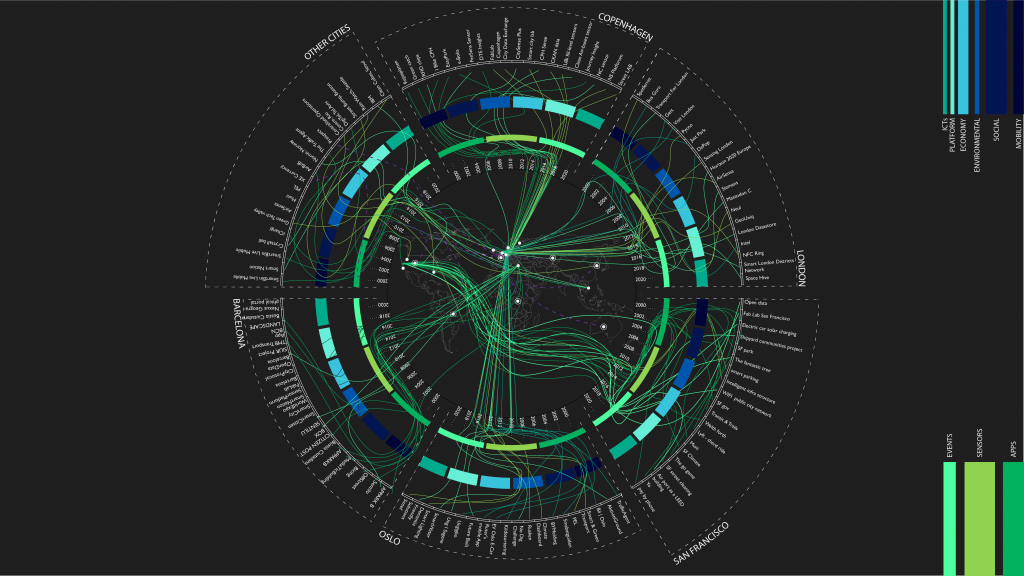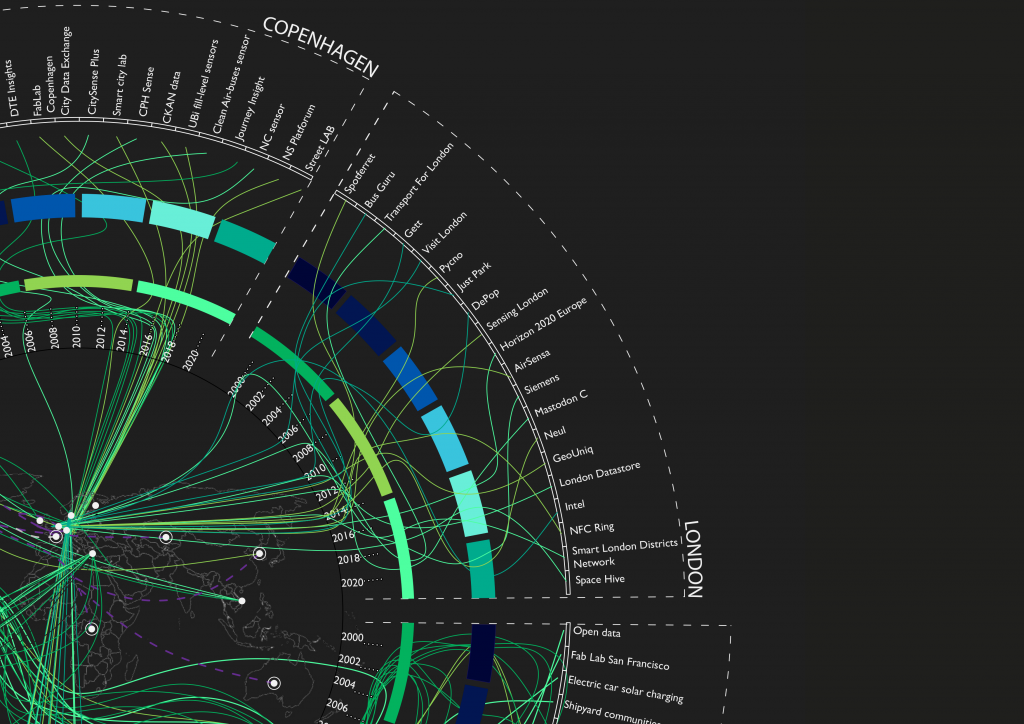The objective of this assignment was to propose a definition for Advanced Urbanism, establish the key categories of Advanced Urbanism and to develop a timefield for the period between 1990-2020.
Advanced Urbanism is the study of citizens interacting with and in urban areas in the information age. It focuses on creating more human focused and transparent systems. New technologies are used for mapping and representing data flows and bits of information embedded in our built environment to improve the design and management of cities.
The key categories within the framework of Advanced Urbanism are :
1. Mobility
Smart mobility is largely permeated by ICT used in both backward and forward applications to support the optimization of traffic fluxes but also to collect citizens opinions about livability in cities or quality of local transport services. Innovative ideas and concepts of smart city mobility help to improve the city’s accessibility.
2. Social
In order to create a truly smart city, one of the most urgent needs is to secure the participation of the people who live there. One way to do that is to encourage their feedback. If citizens become accustomed to regularly contributing ideas, questions, requests and criticisms, policymakers can use these to construct ways to improve citizens’ lives.The ICT platform is the best tool to bridge the current gap between the government and citizens. There are a lot of apps and online platform available to facilitate citizen participation. These inputs are a critical resource for policy-making.
3. Environmental
Environmental change is affecting cities and their inhabitants more regularly. This brings new challenges for city planners, such as the need to improve air and water quality, and control noise pollution to create a healthy and enjoyable environment for city inhabitants. The application of new digital technologies to urban spaces and processes is celebrated for its ability to increase the well-being of citizens while reducing their environmental impacts.
4. Production and Economy
Fab Economy is about creating a new economy for everybody, where local fulfilment and customization take the place of mass production and global distribution. Fab Labs, among companies and organizations, can all work together towards reaching this goal.
5. Collaboration Platforms
Cities Globally work together to replicate Smart City solutions. Platforms deliver a set of tools and guidelines for creating a smart city framework. Platforms allow sharing information with citizens, governments or entities that require it. The purpose of the platforms is to boost interoperability between different sectors, to promote innovation and allow cities to benefit from each other.
6. Tech Companies
In smart cities, many different stakeholders must work together to provide the best technology solutions. Network operators, managed service providers, system integrators and technology providers all have a role to play in working with governments to enable smart city solutions.
The sub-categories within the framework of Advanced Urbanism are :
1. Apps
Citizens, governments and designers have the opportunity to use a wide array of mobile applications to increase productivity, share information, and engage with each other. Mobile applications have value in the work that governments, urban planners undertake and the lives of citizens. Applications understand cities and engage with the public.
2. Sensors
Sensors and data centres in smart cities form the key infrastructure, which allows civic authorities to provide essential services in a faster and more efficient manner. Sensors help in managing public services in real time to improve the quality of life of citizens through traffic management, garbage collection, waste disposal, irrigation systems, assisted parking, alerting the local authority when an incident occurs and allowing the government to stay in touch with the people.
3. Events
Smart City Events aims to be the place of collectivizing urban power, to increase the strength of cities, to identify business opportunities, to establish partnerships and contribute to enacting common policies. A place to share research, best practices and potential common solutions, achieved through effective collaboration.

Timefield for Advanced Urbanism

Timefield for Advanced Urbanism is a project of IaaC, Institute for Advanced Architecture of Catalonia
Developed at: MAA01 2017-2018 Master in Advanced Architecture, Advanced Architecture Concepts
Students: Bhakti Loonawat, Hira Zuberi, Rim Yousef, Tal Dotan, Tawnza El Moujahid and Ashraf Ahamad
Faculty: Maite Bravo and Manuel Gausa
